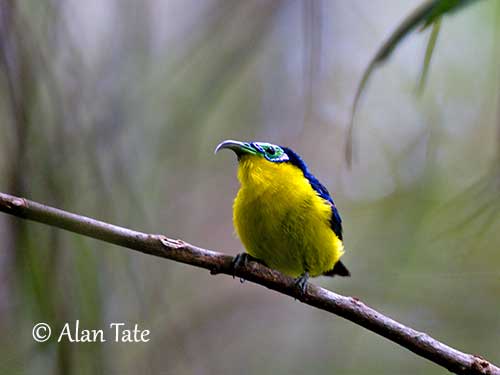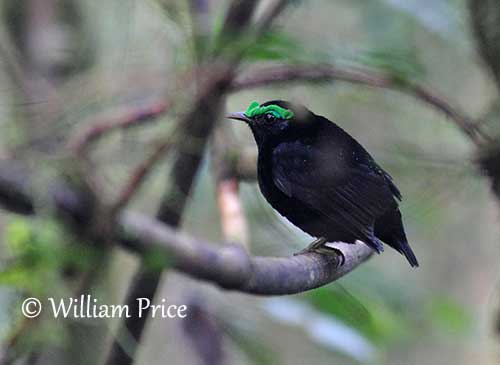
Text by Nicole Bouglouan
Photographers:
William Price
PBase-tereksandpiper & Flickr William Price
Dubi Shapiro
Dubi Shapiro Photo Galleries & Dubi Shapiro's Pictures on IBC
Alan & Ann Tate
AA Bird Photography
Sources:
HANDBOOK OF THE BIRDS OF THE WORLD Vol 8 By Josep del Hoyo-Andrew Elliott-David Christie - Lynx Edicions - ISBN: 8487334504
The Birds of Africa: Volume VIII: The Malagasy Region: Madagascar, Seychelles, Comoros, Mascarenes - Par Roger Safford, Frank Hawkins – ISBN: 1408190494, 9781408190494- Editeur: A&C Black, 2013
Creagus – ASITIES – Philepittidae
Asity - From Wikipedia, the free encyclopedia
FAMILY PHILEPITTIDAE
Asities
(They are now placed in the family Eurylaimidae)
The family Philepittidae is endemic to Madagascar. After travelling around the taxonomy of the bird’s world, these small birds with amazing form and coloration are today included in the family Eurylaimidae (broadbills).
With two genera (Neodrepanis and Philepitta) and four species, this small family includes strongly sexually dichromatic species with breeding and non-breeding male plumages. The males of all species have conspicuous bright blue and green wattles or caruncles, usually enlarged during the displays, whereas the females show drab olive-green to yellow plumages and lack the ornaments.
They live in forests, mainly rainforest but also dry deciduous forest, and all are arboreal species. They can be seen from sea-level to high elevations. They feed on fruits (Philepitta) or nectar (Neodrepanis), but both genera also take insects and spiders, especially during the nesting period. They are sedentary in Madagascar, but they may move according to food resources.
All species are threatened by habitat loss through forest destruction. However, they also frequent secondary forests adjacent to rainforest. Two species are evaluated as Least Concern, one is Near Threatened and the last one is Vulnerable. They are often restricted to small ranges but they also occur in some protected areas.

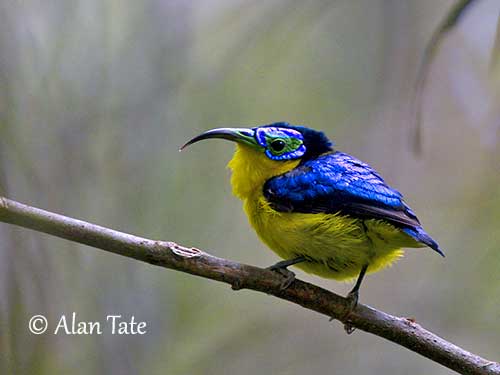
Neodrepanis and Philepitta are two distinct genera, but several morphological features are common to the four species.
The breeding males have conspicuous blue or green ornaments around the eyes. These wattles or caruncles are enlarged during the displays. They have more brightly coloured plumages than females, with mostly yellow and black colours, and the two species of genus Philepitta show blue iridescence on the upperparts.
In non-breeding plumages, the males have reduced caruncles and much duller plumage.
The females resemble non-breeding males. They are mostly olive-green above and yellow or whitish below. They lack the wattles and are duller overall. Juveniles and immatures are similar to females.
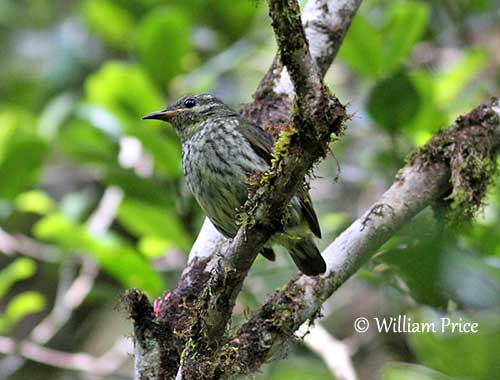
Female
Asities occur mainly in the eastern rainforests, except the Schlegel’s Asity which is found in lowland seasonally dry rainforest on west and north, up to 800 metres of elevation. The Common Sunbird-Asity is the only one that has been recorded on the central plateau in addition to rainforest. It is most common around 1,000 metres. The Yellow-bellied Sunbird-Asity is present in numerous blocks of eastern forest above 1600 metres and in some well below this. The Velvet Asity is found at all elevations up to 1,600 metres, except the low-altitude forest below 400 metres. All species are absent from littoral forest on sand. The three rainforest species occur from the far south of the rainforest belt to the far north.
The sunbird-asities of genus Neodrepanis feed mainly on nectar from several flowers, and have adapted bill and tongue. They have a long, decurved bill, short legs, and tubular tongue, allowing them to extract the nectar with the long bill or sometimes only with the tongue, depending on the flower shape.
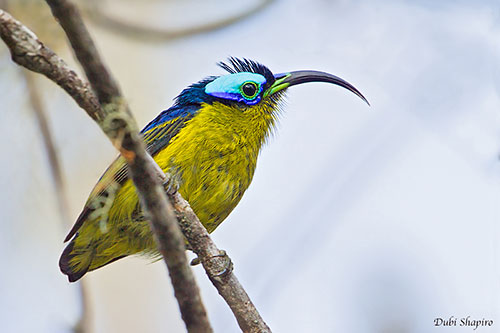
The asities of genus Philepitta are primarily frugivorous and have a slim, slightly decurved bill. They perch and pick fruits and berries, or hover in front of the plant while picking them. They also take nectar, but if they lack the tubular tongue of Neodrepanis, their tongue has brush-like tip.
Both genera feed on insects and spiders, especially when feeding the chicks and during the cool season. They extract arthropods from under flaky bark or dead vegetation and probes wood and bark crevices. Both sunbird-asities may sally-glean and sally for insects, especially when they are in mixed-species flocks. They can be seen in small groups, probably family parties between June and September. They are always very active while feeding.
The Philepittidae generally give weak, squeaky calls, but the most powerful is the penetrating whistle of the male Schlegel’s Asity, delivered from treetop or from within vegetation. The calls of the Velvet Asity are squeakier and less powerful, and the song is not as clear as that of the previous. The male produces a whirring sound in flight and during the displays, the wings make a mechanical noise.
The Common Sunbird-Asity gives repeated series of penetrating hisses, whereas the Yellow-bellied Sunbird-Asity has much weaker calls, fairly similar to the sounds made by a tree-frog.
Both sunbird-asities produce some buzzing or whirring noise in flight, caused by the long, emarginated first primary flight-feather.
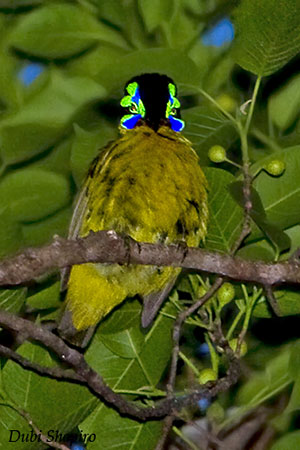
Asities have complex but interesting breeding systems, and for all species, polygyny could be possible. However, the breeding strategies are flexible and depend on resources availability.
The Velvet Asity has a polygynous breeding system with males mating with several females, and displaying at dispersed lecks. Only the female incubates and rears the young. Several males compete among themselves in these areas, displaying and calling in ritualized postures that enhance their bright-coloured face pattern.
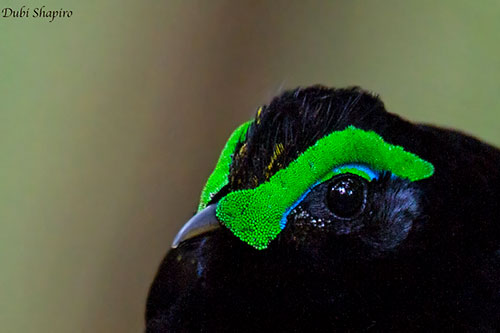
The displays of the Schlegel’s Asity are poorly known, but they are rather different from the previous from some observations. However, the male sings from within a restricted area indicating that this species could have dispersed leks too. But more information is required.
The breeding habits of sunbird-asities are not very well known either. The Common Sunbird-Asity usually occurs high in the subcanopy and is difficult to observe. However, the Yellow-bellied Sunbird-Asity displays its blue and green caruncles by head-turning, mostly directed towards intruders or other males. Other displays accompanied by loud calls are directed to females.
As the males of all four species have conspicuous bright-coloured face patterns, we can suggest that they use adapted posture in order to enhance these ornaments in front of females for courting them, and towards other males or intruders as intimidation behaviour.
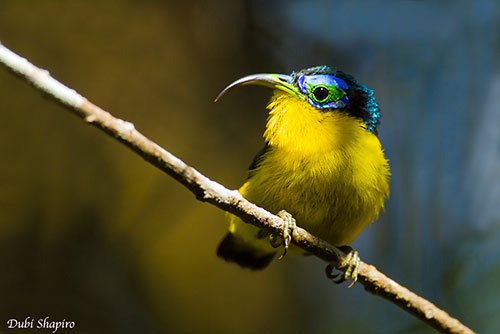
The breeding season of the three rainforest species with displays and nest-building takes place from September to November, with some variations from north to south of the range. This season coincides with the Malagasy rainy season. The sunbird-asities appear to have more extended season, from August to January, but with peak in October-November.
Males of sunbird-asities lack brood patches, but they have been observed near the nest during the construction or visiting the nest to feed the chicks. The female Velvet Asity builds the nest and incubates alone, and the male may occasionally have a reduced contribution to the nesting duties.
The Schlegel’s Asity builds the nest between October and December. It accompanies the female while she is collecting nest-material and may sometimes take part in nest-building.

All asities build a hanging spherical or pear-shaped nest. It is often made with bamboo, roots, moss, grass, strips of bark and leaves, held together with spider webs. An entrance hole is made by poking the bill through the wall of the side of the structure, instead of weaving the hole while building the nest. Some overhanging grass shelters the entrance.
The moss is the most used material, but nest-materials may differ slightly depending on the location. The nest of the Schlegel’s Asity is mainly built from strips of bark and dead leaves, because there is little moss in the west of the island.
The nests are suspended from branches of shrubs or low trees, between 2 and 5 metres above the ground.
The clutch size is poorly documented. From some observations, the Velvet Asity lays three eggs, and two eggs were found in each nest of both sunbird-asities. Nothing is known about the clutch of the Schlegel’s Asity. Incubation and fledging periods are unknown either.

All asities are sedentary in Madagascar. Some altitudinal movements are probably performed, especially by the Yellow-bellied Sunbird-Asity, related to lack of food at high elevation. The other species only perform some movements associated with food availability.
Asities have short tails and short wings, involving short-distance flights. They usually have fast and direct flight during which the wings produce a distinctive whirring or buzzing noise due to the emarginated first primary.
The asities play an important role in regeneration of forests, are significant dispersers of seeds and assist in pollination (at least the sunbird-asities). In addition, their extreme attractiveness makes them a popular target for birdwatchers and researchers.
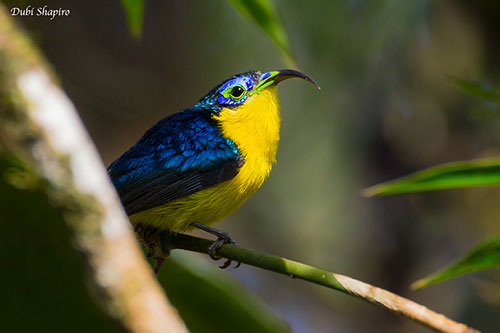
The Philepittidae are vulnerable to human activities. They largely depend on forest and are threatened by habitat loss as the forest is continuously cleared for agriculture, mining and timber. They often have fragmented range, but they occur in several protected areas such as national parks and reserves that should help their future survival.
The species living at high elevations are less threatened because these pressures are less marked in montane forest than in lowland.
The Schlegel’s Asity is listed as Near Threatened.
The Velvet Asity is evaluated as Least Concern.
The Yellow-bellied Sunbird-Asity is listed as Vulnerable.
The Common Sunbird-Asity is evaluated as Least Concern.
